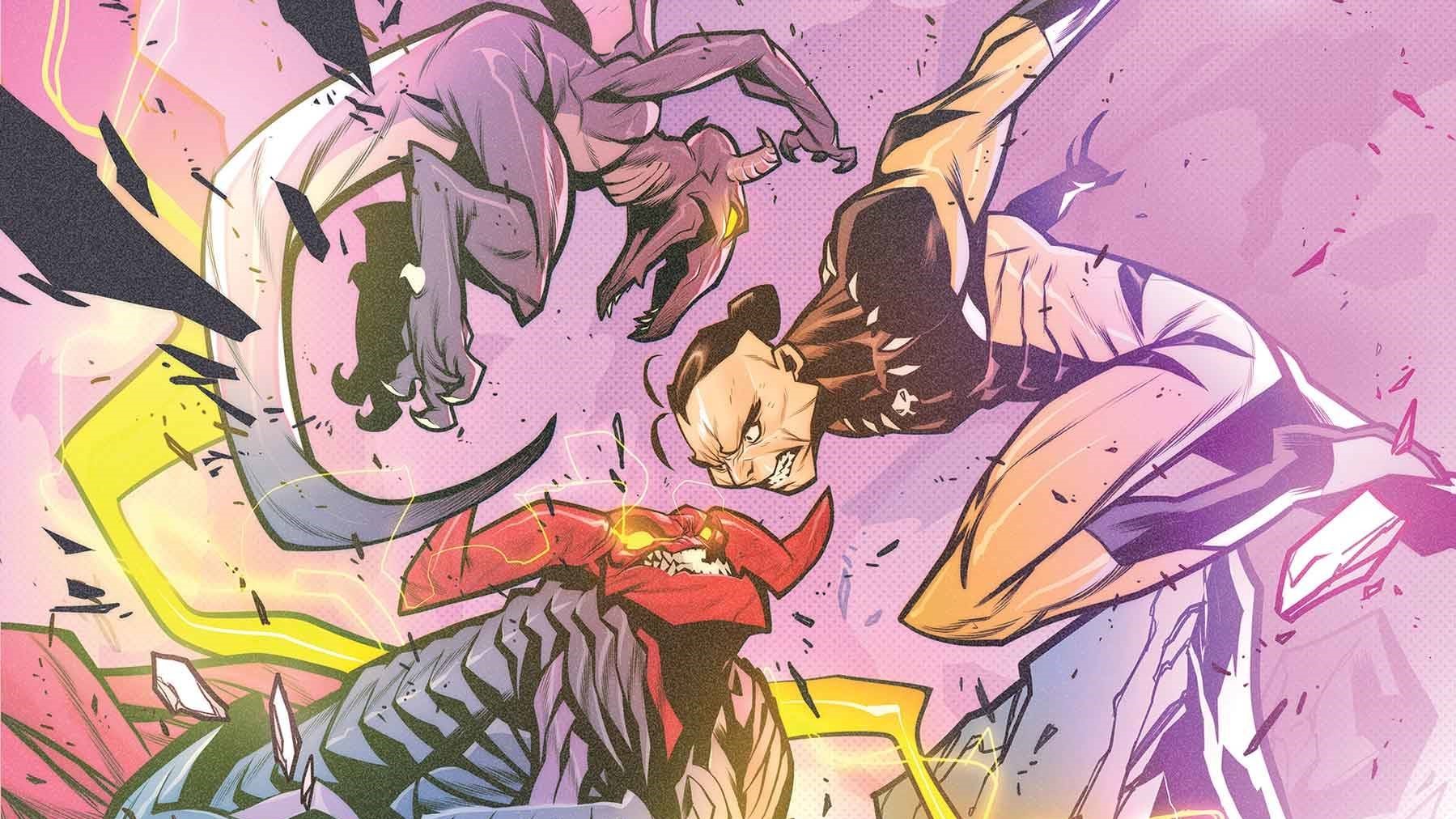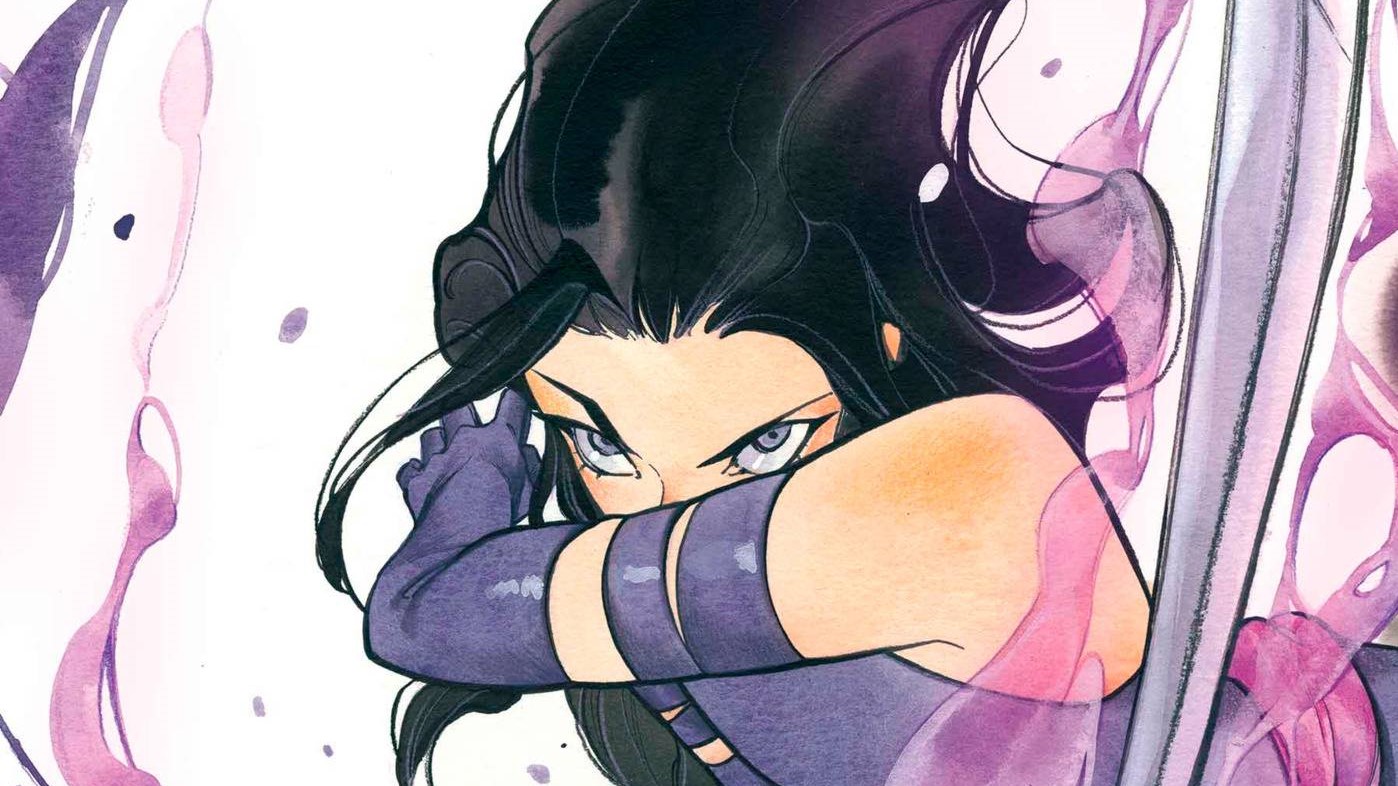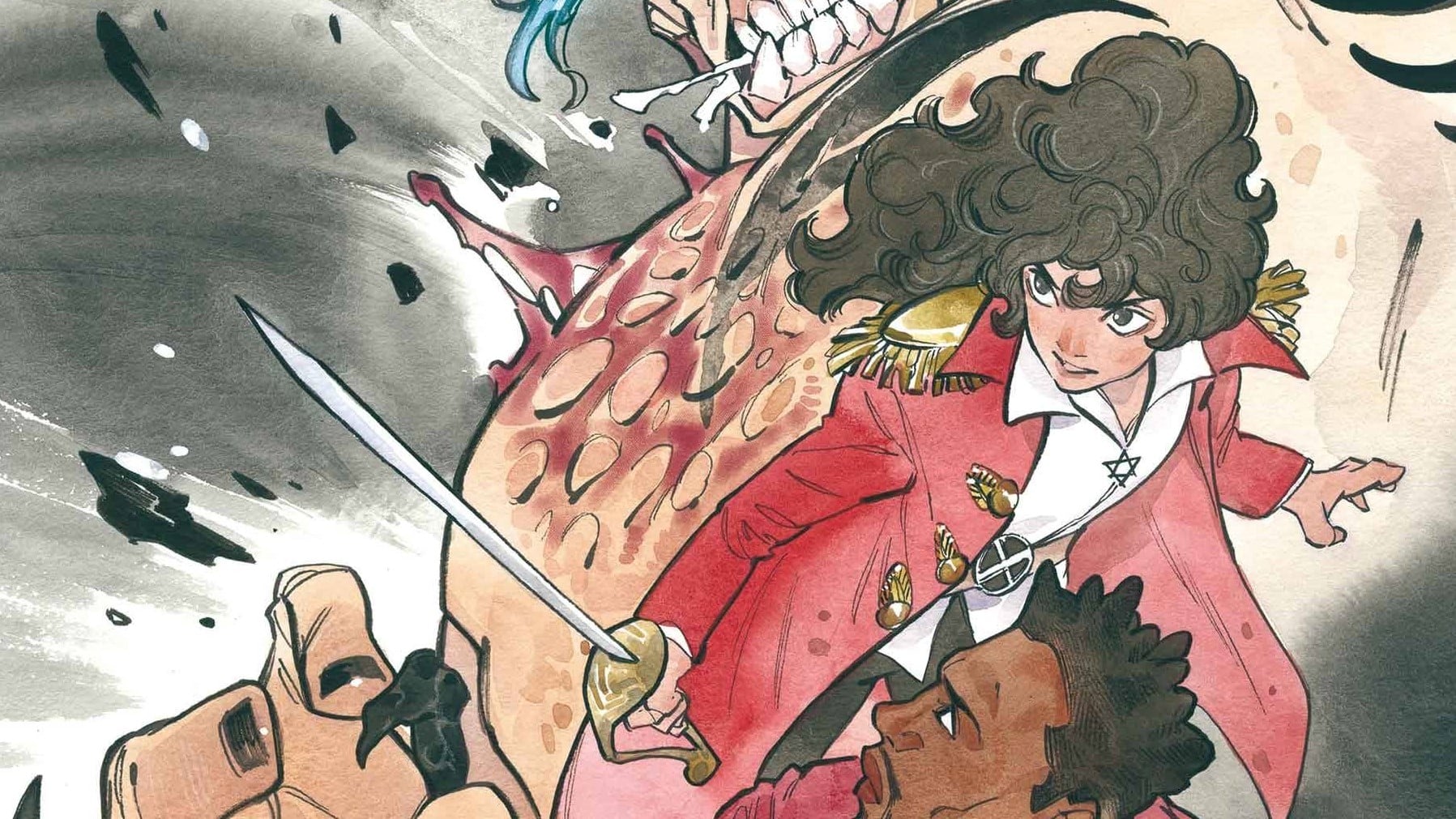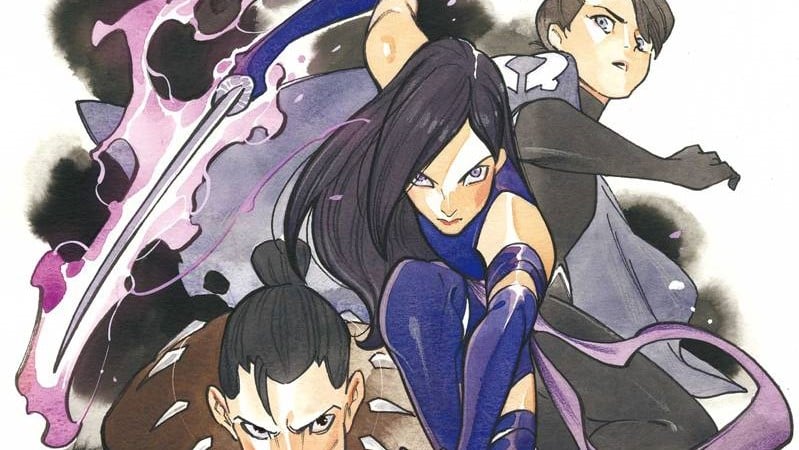Our Marauders have been to space, welcomed a mutant from 2099, taken a deep dive into the Proterozoic proto-ocean, rescued a couple of ancient mutants from yet another genocide, and wondered who made a mysterious puzzle box. Now their series is ending. Will their questions get answered in Marauders #12, written by Steve Orlando, drawn by Eleanor Carlini, colored by Matt Milla, letters by VC’s Travis Lanham?
Ian Gregory: I don’t know about you, Stephanie, but somehow the news of Marauders ending took me by surprise last week. We’ve been up and we’ve been down on this book, but I have to say that I’m sorry to see it go after Marauders #12. Even the stuff we haven’t liked has led us to some interesting places, and I think this issue is no exception.
Stephanie Burt: Same. I’ll miss it. But also? The whole series seems to have had an arc, with multiple time loops. And it ends. Right. Here.
Rolling Up the Welcome Mat

Ian: We’ve got two competing stories running through Marauders #12. The long-teased resolution to the Brimstone Love storyline, and Kate turning the dead Genoshans into Threshold. Let’s tackle the first story, if only because it’s very simple. Fang gets in a fight with Brimstone Love with Lockheed support, and then reveals that, before the fight had ever begun, he fed one of Brimstone’s horns (cut off in the Marauders Annual, oh so long ago) to Johnny Dee. You’ll be forgiven for not knowing that Dee’s power is to produce stereotypical voodoo dolls of people whose body parts he consumes in his chest flesh mouth, at which point Lockheed burns the doll and kills Brimstone.
At least Orlando takes the time to explain all this as it happens, but this really felt like he was scrambling to finish up a dangling storyline before the series ended.
Stephanie: On the other hand it’s gross and silly and I don’t need to see any more of it. Johnny Dee is the subject of a catchy song by the 1980s pop group the Chesterfields, and also a metal drummer and he appeared in The 198 and at least these three horror-themed dudes, who aren’t even fun to watch and don’t banter, get shunted off into their own B-plot that ends neatly, assuming that Fang and Johnny Dee have access to a fire extinguisher and a ShopVac.
Ian: I really like artist Eleanor Carlini’s work throughout Marauders #12, but this scene in particular is good. I like how Lockheed’s coiling body forms the panel division on one page, and the half page of Brimstone’s immolation is just perfect. This is a solid fight, but like the later diversion to see What Cerebra’s Up To, it feels like it’s leftover from some draft of the story where the X-Men 2099 riffs had an entire arc to breathe, and not just two half-issues.
Stephanie: I agree with you about the Brimstone Love fight but not about the Cerebra sequence, the book’s C-plot. Can we talk about that?
Ian: Sure! She’s in San Francisco to save a mutant named Esera, with the power to dowse for water. Esera’s descendant was… will be… one of Cerebra’s teammates in 2099, and so she needs to protect him from Bushwacker, who is not Random and actually predates Random by several years. This whole fight is an almost nothing sequence where Psylocke arrives to disable Bushwacker, Cerebra explains her concept of protecting her future, and they leave. Yet another beat that feels like it should have been a bigger story.
Stephanie: Here I disagree. It’s a one-off mutant rescue, like the Tristan da Cunha story from <> from New Mutants #20. And I love it. Not just because Esera could use a rescue, though that too, and not just because these queer or queer-coded mutants missed out on the Utopia/ San Francisco X-era, though that too, and not just because San Francisco is fun to draw and we haven’t seen outdoor urban combat at all in this series, though that too: Esera’s future bloodline includes Cerebra’s future teammate Northstar.
This quick scene pushes a few of my favorite buttons! A friendly mutant of color with a body type we don’t see in comic books often displays a super-helpful non-combat power that ties in to current events (the California drought). Plus Cerebra gets to shout at Bushwacker, in a panel full of green force-lines, “Maybe I can’t breach your mind, but I can shut you down the CLASSICAL way!” And then she recites the Aeneid until he drops. Just kidding: she punches him and then rewrites his mind. Seriously, though, this whole plot line has strong Aeneid vibes. We can talk about it later. Or earlier, since there’s a time loop. Multiple time loops!
Heart-Shaped Box

Ian: Let’s get into the real meat of Marauders #12, which is the stuff on Genosha. First, Polaris just whips together a mysterium box, which is evidently something she can just do? Oh well, that page looks great. Kate then gets a pretty good conversation with her dad that I wish went on for more than two pages. Still, I’ve always liked the dynamic between Kate and her father. It’s a kind of sadly refreshing change to have a parent who cares about mutants and is accepting of their child being on the X-Men.
Stephanie: Carmen Pryde has had a few arcs of his own, but yes, he accepts Kate, and I love that. Polaris just puts together the box with her magnet powers; the circle of mutants later does the rest. I think. And yeah, it’s beautiful. Carlini took a while to learn to draw a Kate whom I recognize as My Red Queen Captain Kate Pryde, but she does it now, just when the series is ending! She’s expressive, outwardly confident, determined, and able to lead a team. And she’s someone who needs — not wants; needs — a strong purpose. Otherwise she gets anomic and sad. “Who are we,” as Amass says, “to argue with a Katherine?”
Sorry (not sorry). I’m projecting, as I sometimes do when I write about Kate. Imagine being able to address your family trauma with the aid of a mutant circuit, a telepath with a connection to the afterlife, and the resources of Krakoa. And looking great doing it. It’s a sequence I may keep rereading, and I wouldn’t have said as much about most of the rest of the Orlando/Carlini run.
By “family trauma” I mean both Carmen’s death on Genosha in the Morrison run and the real-life Holocaust, which Kate certainly has in mind. “We say the book’s not closed.” “I never forgot.” And she’s drawing a map with her father’s hand on the pen (shades of Torah-scribe practice here). And, as Theia says later, “those lost decided to bring new life with this land.” It’s taken twelve issues but Orlando’s writing has finally engaged in a serious way with Krakoa as a mutant homeland, as the refuge that Labor Zionism (RIP, I guess) wanted real-life Israel-Palestine to become. Given what real-life Israel and Palestine are experiencing these days it’s a very good time for a self-conscious fiction about how fiction can show us other ways…
Ian: That’s a good point. I think, too, there’s something significant to the idea of giving Genoshans a life beyond their signature tragedy. In the end, very few named characters died on Genosha. The Big Name Mutants got away and got to star in series for years. One of the big criticisms of E is for Extinction as a story is that it basically genocides an entire island for shock value and very little character impact. Besides Emma Frost, how many characters can we say were truly affected by Genosha (not counting Evil Magneto, who has been relegated to the dustbin of time)?
Visually, the sequence of packing all the ghosts of Genosha into the mysterium box is excellent. The page of focus on the ground and their feet that transitions into the full-page of the DNA monument paired with the Krakoan gate is pretty excellent. I think that Carlini works best when she’s given these big, fun setpieces to draw.
Stephanie: Yes yes yes yes yes. I believe in these people and their feelings, as conveyed by their stances and their facial expressions! I’m won over. I even believe in the canned queer liberation dialogue that Tempo recites for her new gf Theia.
I wish we had a bit more explanation for how the box works to create Threshhold, though. The box sends the ghosts of the people who died on Genosha, all the baselines humans and all the mutants, back in time, right? Then Tempo and the mutant power circle send Kate back in time to deposit the box in the primordial ocean. And when the box opens itself up, with the ghosts and also the map and the manuscript, the ghosts will… become the first mutants? Is that right? Is that how it works?
Ian: There’s definitely a bit of magic in between “drop box of ghosts in the sea” and “millions of mutants appear spontaneously.” I think what gets me to look past that weirdness is Carlini’s expressive and joyous art.
Ultimately, this resolves my main issue with Threshold: the fact that it was so arbitrarily far in the past that it ought to have defied any sort of mutant or human origin. In fact, Threshold so closely matches the human/mutant divide because it really was modern mutants, given a chance to live freely in the past (until they were wiped out by Sublime and Arkea, of course). The original map, written in Kate’s handwriting, really was written by Kate and stuffed in the box to be retrieved by herself. It’s a fairly well-closed time loop, if one that took a long time to resolve.
Stephanie: Two closed loops, counting Cerebra and Esera! But yes. Yes yes yes yes yes. It’s also self-conscious and self-referential about how modern mutant comics keep looping and pointing back at their own Bronze Age beginnings. Like Kate Pryde, the famous (or infamous) reader surrogate in her earliest appearances, sent her dad’s X-Men collection back through time in a longbox in order to cause the invention of mutant comics by Lee and Kirby and/or Claremont and Cockrum and Simonson and so on, so long ago…
The metacomics part of this conclusion works so lightly that you have to look for it to find it, though, which is how metacomics ought to work (as Al Ewing knows — he’s thanked in this issue, btw). I love how we get seven entire pages of Kate’s team sending the box back in time, Kate planting the box in the ancient ocean, Kate hanging with Emma and debriefing over what might be champagne (or cider or mango juice in a champagne glass). She’s earned it. They’ve all earned it. Matt Milla’s colors, in particular, have earned it. Check out the blues in that archaic sea.
Space Pirate’s Love Song

Ian: Let’s take a step back and talk about this series as a whole. Overall, we’ve criticized this series for feeling very unfocused and removed from its themes and characters in favor of high-concept, science fiction and continuity stories. I don’t think those criticisms are incorrect, ultimately, but I do appreciate what Orlando was trying to do here. I like how hard Orlando worked at tying all the story stuff to individual characters. Kate ultimately got some interesting work in this series, and I feel like Orlando has done more for Tempo than anyone else has ever attempted.
Stephanie: The journey was rough, but you know what? He landed the plane. Or the spaceship, or the timeship, or the chronotropic mysterium box. Tempo still feels like a collection of tropes, though. She even gives a canned generic-minority mutant metaphor speech — to her time-displaced girlfriend! “Mutants have the right to liberation. To live. To love — beyond today’s judgement.” And Theia reacts quite appropriately: “How long did you practice that speech?’
Ian: Perhaps I’m setting the bar too low. But I like that I can look at Tempo and know more about her character than just her power. I know her opinions on time travel, and that she’s mourning the loss of a meaningful friendship taken from her by her power. I know that, despite her dire warnings about time and consequence, she’s ultimately a bit of an optimist and romantic. But also, you’re right that she’s kind of got the mass-produced mutant-queer dynamic that doesn’t feel particularly developed or earned.
Almost unbelievably for a 12-issue series, this run felt very cramped. Orlando was working with some complex ideas that I know feel flat for a lot of people, or just weren’t sufficiently explained. I think that, with close reading (and rereading) everything adds up, but it’s definitely not very approachable as far as Big 2 superheroics goes. Even if I was pretty regularly disappointed that Marauders felt removed from the other works in the line — and from regular mutant life in general — I liked that Orlando took some big conceptual swings.
Stephanie: Nod nod. I wish I could recommend the last two issues to people without making them hack their way through the complicated space plot. Everything really does add up, and I think if you’re used to reading certain kinds of science fiction the story becomes approachable. If you’re looking for an entry point to the Krakoan era, on the other hand, this book ain’t it.
Ian: I don’t know for sure if Carlini’s art has improved, or if I’ve just become accustomed to it, but in the end I really like the way this series looks. I think besides some of the more baffling decisions (like those four issues where everyone was dressed in helmets and identical bodysuits), I think she ended up working very well on a science fiction series with lots of visually unique elements. Marauders had a strong visual identity through all twelve issues, and I’d much rather a distinct but imperfect series than something in the house style.
Stephanie: I agree. But I also think she… learned to draw these characters expressively, authentically and consistently. I hope she gets more cartoony space opera work. But, and I’m surprised to say as much given where I stood a year ago– I’d be delighted to see her draw these characters again. Just don’t put them into identical face-concealing pressure suits.
Ian: I have pretty mixed feelings about this series overall. I liked it, and I liked lots of individual moments, but for what was technically “one big story,” it felt pretty disconnected from itself. I suspect that a lot of the ideas here may be lost to time and never revisited, but I like that Orlando was willing to go into new spaces. What do you think, Stephanie?
Stephanie: I think the last two issues of this series handled the A-plot’s resolution beautifully, put Kate back at the center of the story where I want her, addressed a major part of her psyche that we haven’t seen lately, and neatly resolved the biggest problem, or the worst inconsistency, throughout the first ten issues, in a way that’s got neat meta-commentary trailing along beside it like a beautiful bronze comet’s tail. Why have there always been mutants? Because today’s Krakoan mutants put them back there.
Ooh, you know what? Before we leave this series behind, I’m gonna address the time loop and the hermeutic circle that this series’s ending creates along with its real-life, non-comics counterparts. Have queer people always been here? What about trans people in history? Are we something new, and weird, and contingent? When we look back at the past for our ancestors, are we just projecting ourselves back into a past that could never contain us?
These questions in real life have real world stakes, since people who want to outlaw (for example) me like to claim that transness is something new. We can answer that question by looking for long-ago trans people like Lucy Hicks Anderson, or maybe Joan of Arc. Or we can say: that’s not the point. Maybe we’re changing history by being here now. And we deserve our lives.
Yes, Ian, I have come around on this series. It’s hokey and flawed and imperfect, but this team really delivered at the end. “Start with the end, kiddo. It’s the last thing I remember,” as Carmen Pryde tells Kate Pryde, surrounded by blue-green ghost-smoke.
Good idea.
Our Flag Means Notes:
- Another nice art touch: love the unspooling DNA from the mysterium box when it’s dropped in the primordial sea.
- Aeneas is canon on Marvel’s Earth-616, thanks to some 1970s Thor comics, though the planned Thor Annual retelling the Aeneid never appeared.
- The second data page is Theia’s olde-timey-lettering epilogue to the whole series (“A People Reborn”), but the first data page points forward: Magik describes Cerebra admiringly, in terms that could frankly apply to Kate. Is this the beginning of a beautiful friendship?
- Kate gets to hug her dad. “The ghosts are watching.” “Don’t care.” Love it.







